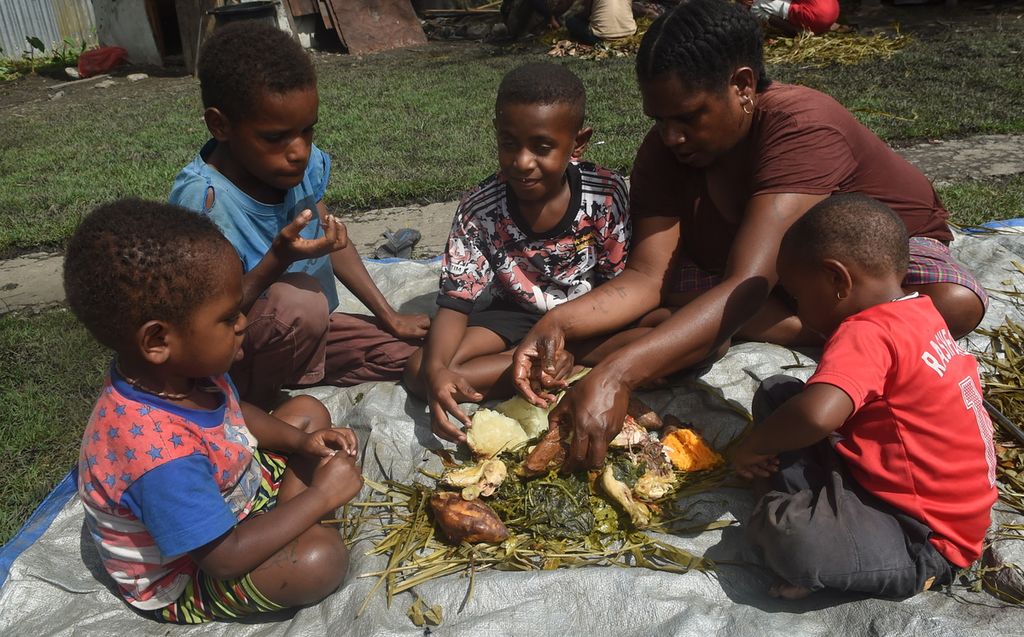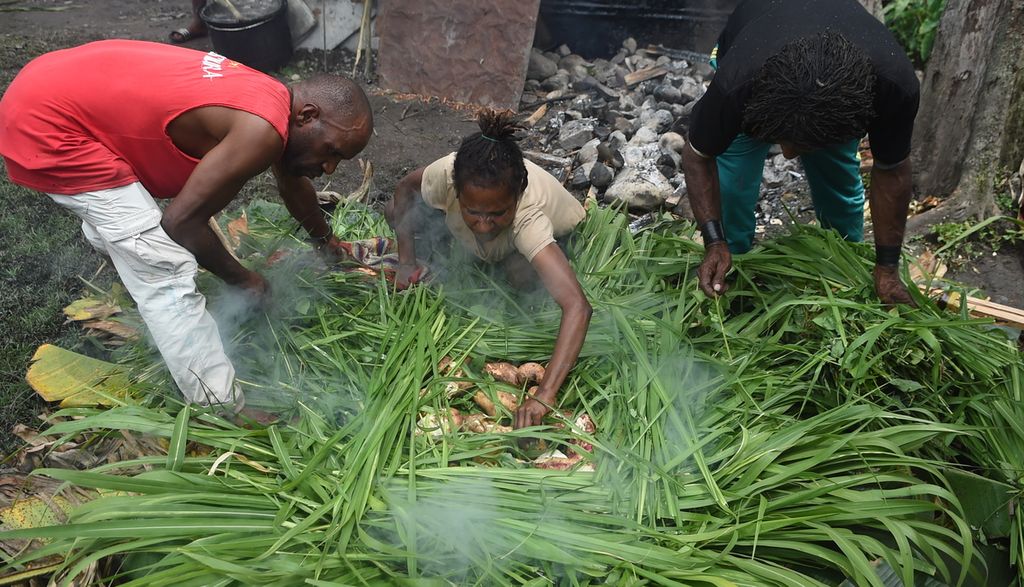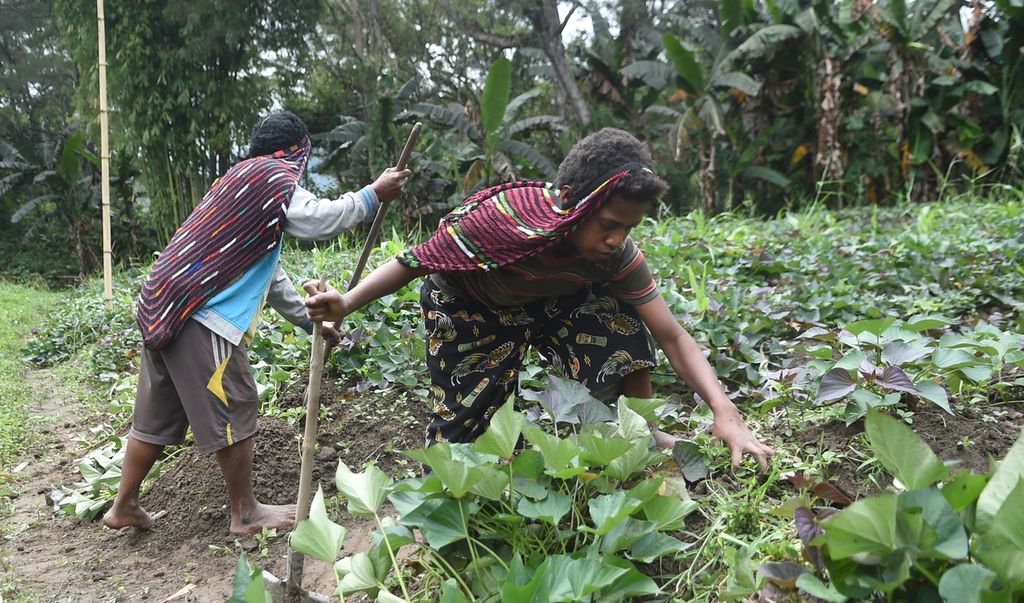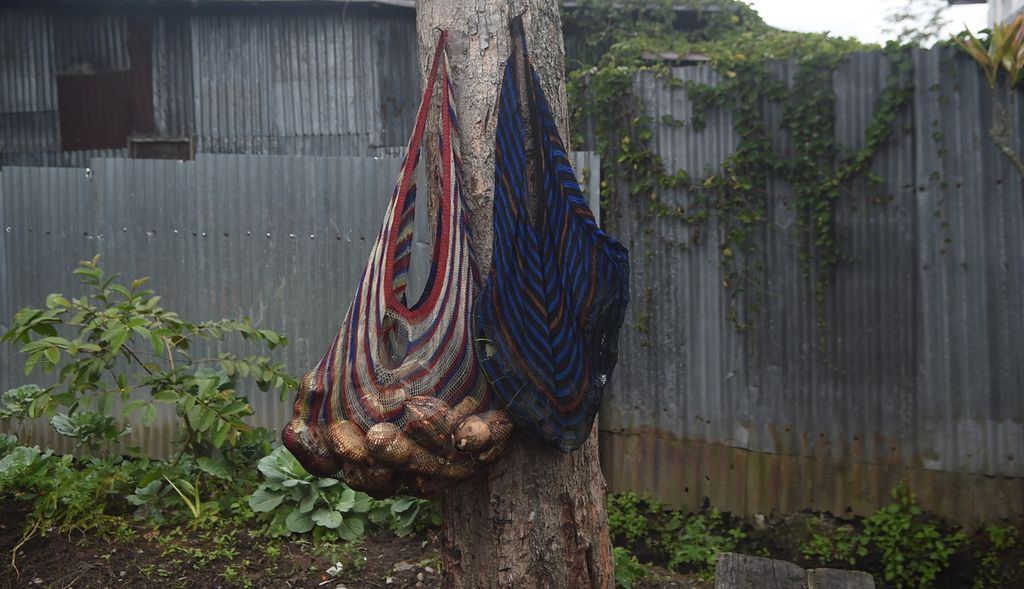Sweet Potatoes No Longer Favorite
From the early 1970s, Musa said, he started learning about rice. Occasionally he ate the rice the government distributed for civil servants like him. However, he learned a new rice-planting technique in the early 1980s.

Residents eat sweet potatoes together in a stone-burning tradition in Wamena Kota District, Jayawijaya Regency, Tuesday (16/11/2022).
Sweet potatoes, which used to be planted and consumed by people in Jayawijaya regency, Papua, have begun to be replaced by rice. It is also feared the sweet potato culture is fading.
Under the scorching sun, Musa Aso kept wielding his spade in his rice field. He raced against time to plant in these patches of rice fields that were once sweet potato fields. Rice is now the main source of food and livelihood for the Musa family, replacing the sweet potato, which has been the staple food for centuries in the Baliem Valley and its surroundings.
At the age of 64, Musa is able to skilfully wield a spade in the rice field, which is being worked on in Mulinekama village, Asolokobal district, Jayawijaya regency, Papua. This village is about 10 kilometers from Wamena, the center of Jayawijaya regency.
Also read:
Hoeing Sago in the hinterland of Boven Digoel
The spade is the main tool for cultivating the land, not a hoe like in many places outside Papua. A tractor occasionally helps if someone lends it, or there are funds to buy fuel. The price of fuel in Wamena, Jayawijaya, is Rp 20,000 per liter.
Together with Fando Lakobal (18), one of his seven grandchildren, he focuses on deepening the edge of the rice fields. All the edges are dug to a depth of about 10 centimeters. The soil is thrown into the middle of the rice field, which is higher.
"This is for us to seed fish later. People say this is the ‘mina padi’ method," said Musa, one afternoon in November 2021.
"If the two plots of rice fields have been planted, you just have to keep the water in check," he continued, showing the rice fields where the plants were starting to grow.
At an altitude of 1,600 meters there is a cool breeze. However, the hot sun still dazzles the eyes and burns the skin. Musa and Fando seemed to have made peace with the weather, and continued to work, racing against time so they could plant immediately.
He had already worked more than four hours. Since the sun began to rise, Musa had worked one of his eight plots of rice fields. A total of 1 hectare of land has been turned into rice fields.
At that time, Jayawijaya was closely monitored by the security forces due to the unstable security situation. Deployed military personnel then introduced rice and rice-field techniques.
From the early 1970s, Musa said, he started learning about rice. Occasionally he ate the rice the government distributed for civil servants like him. However, he learned a new rice-planting technique in the early 1980s. At that time, Jayawijaya was closely monitored by the security forces due to the unstable security situation. Deployed military personnel then introduced rice and rice-field techniques.
At that time, no one had grown rice in his neighborhood. For over a kilometer stretching behind his house were hectares of sweet potato fields up into the hills.
Together with his children, he began to cultivate two plots of land into rice fields. Seedlings were brought in from the adjoining district, which planted rice first. Loose soil contours allowed the plants to thrive.
The first harvest, which was quite good, encouraged him continue to work in the fields. His children started eating rice. Sweet potatoes in the morning and evening, rice in the afternoon.
“This rice is organic, it can be sold for Rp 40,000 per kilogram. People like it. The proceeds from selling rice are spent on buying side dishes. We still keep planting sweet potatoes. There is a small bit of land in the front yard, enough for a family,” said Musa, a father of 12 children.
Musa added that sweet potatoes still play an important role in his family’s diet. Every day, sweet potatoes in the fields are harvested for the main meal. This is because most of the rice is sold and the proceeds are used for other necessities.

Residents arrange sweet potatoes to be used in the stone-burning tradition in Wamena Kota District, Jayawijaya Regency, Tuesday (16/11/2022).
A different atmosphere can be seen in Jagara village, Walesian district, a few kilometers from Mulinekama village. Markus Lani (69) has just finished cultivating a plot of land. Next to him, swaths of sweet potato fields have turned green.
This sweet potatoes were planted two months ago. In about three months, sweet potatoes can be harvested for family needs, livestock and other traditional needs. Markus is one of the chiefs of the Lani tribe, a tribe that inhabits the Baliem Valley.
In his fields, he still grows various local sweet potato varieties that have been planted by the community. There are helaleke, yeleli and musaneken sweet potatoes. There are dozens of sweet potato species in this region.
Also read:
Sago as Raw Material for Instant Noodles
Although he still continues to plant and eat sweet potatoes, Markus feels that the community's attachment to this staple food is starting to fade. Local people, especially children, are more likely to prefer rice. Sweet potatoes are only an option when there is no rice to be had in the kitchen.
Shift
The chairman of the Jayawijaya Indigenous Society, Herman Doga, said that in the mountainous communities of Papua, there has been a shift in diet, from sweet potatoes to rice. This situation began to occur in the 1980s and continues to this day.
The shift started with the provision of rice assistance to the community and the introduction of the rice field system. People who previously did not know about rice gradually switched and made rice their staple food. Periodically, said Herman, people who fall into poverty are also given rice assistance by the government.
Sweet potatoes are grown for daily meals, as fodder for livestock and during traditional ceremonies.
However, people in the mountains of Papua have always only known taro and sweet potatoes as staple foods. Sweet potatoes are grown for daily meals, as fodder for livestock and during traditional ceremonies.
“Children in the city don't know how to eat sweet potatoes because they are always given rice. If it's rice, the pigs can't eat it. People don't know how to grow rice. They only know how to grow sweet potatoes, which is easy, and doesn't require much care,” Herman said.
If this situation continues, Herman said, he is worried that people will increasingly abandon sweet potatoes and switch to rice. When that happens, and the agricultural conditions in the mountains do not support rice fields, there will be the potential for food shortages.
"Such concern exists because people do not know how to plant rice, they just have to wait for rice assistance, which may not always be available," he said.
Food scarcity potential
Head of the Jayawijaya Agriculture Office, Hendri Tetelepta, revealed that the shift in people's eating habits has raised concerns about food scarcity, especially when local farmland is decreasing.
However, said Hendri, one thing that continues to be done in the midst of this situation is to encourage the cultivation of other crops. "One of these is rice, the swamp plant," he said.
According to Hendri, sweet potato development is not pushed through government projects. This is because the sweet potato has taken root as a daily staple food, as well as for animal feed.

Residents weed a sweet potato field in Jagara Village, Walesi District, Jayawijaya Regency, Papua, Tuesday (16/11/2022).
Hendri said that if sweet potatoes were intensified through projects, people would be lazy to grow sweet potatoes, and would wait for the projects to start working. "So the sweet potato development program only assists them as they go along, as they have been doing for generations. We only introduce the seeds from outside," he said.
In fact, the nutritional content of the sweet potato fulfils the requirements of a staple food. A Wahid Rauf and Martina Sri Lestari in "Utilization of Local Food Commodities as Alternative Food Sources in Papua", which was published in the Research and Development journal of the Agriculture Ministry explained that sweet potatoes contain carbohydrates, fats, proteins and minerals not much different from other local food sources. This shows that sweet potatoes are suitable to be used as the main food source for the community. If necessary, other nutritional elements can be added through the fortification process.
Martina Sri Lestari, who is also the head of the Agency for the Assessment and Application of Technology (BPTP) in Papua, in an interview in November 2021, said that sweet potatoes face various challenges, both changing diets and a reduction in seed clones.
This happens because of land use change, population migration and changes in food culture in the community. Over the past few decades, people have become accustomed to eating government-distributed rice. People who come back from the big cities stop eating sweet potatoes. Not only that, the reduction in the number of farmers due to population migration has meant the crop is not managed well.

Sweet potatoes to be used in the stone-burning tradition in Wamena Kota District, Jayawijaya Regency, Tuesday (16/11/2022).
Dietary changes among the people of Jayawijaya, and its surroundings, are very real. As Markus Lani said, “There used to be a lot of sweet potatoes. Now there aren’t. In the past, when people farmed and they called [for help] many people would come. Now it's hard. Yet all of life is in the sweet potato. The sweet potatoes feed us, and take care of us."
(This article was translated by Kurniawan Siswo)